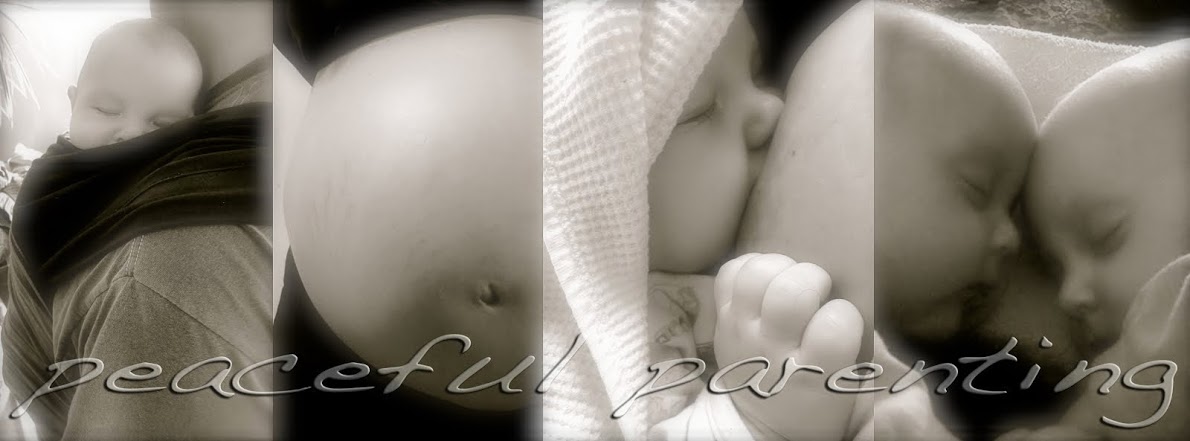The following are parent-to-parent closed (non-public) discussion groups on Facebook. Read each group's description prior to joining (in the 'about' section at the top righthand side of the group).
Peaceful Parenting Group: FB.com/groups/ExplorePeacefulParenting - for families striving to parent in baby- and child-friendly ways.
The Breastfeeding Group: FB.com/groups/Breastfed - for all nursing mothers, lactation consultants, and female lactivists.
The Baby-led Weaning Group: FB.com/groups/BabyLed - for families practicing baby-led weaning and natural 'child-led' weaning.
The Birthing Group: FB.com/groups/Birthing - for birthing women and mother/baby-friendly birth advocates.
The Due Date Group is for all expecting mothers with babies arriving this year. This is a 'mainstream' group, with a baby-friendly foundation, and with opportunities for outreach with parents who may not be familiar with peaceful parenting. FB.com/groups/DueDateGroup
Beyond Birth is a mothering group to follow the Due Date Group. It is meant for all discussions beyond pregnancy and birth, and is more of a 'mainstream' group (like Due Dates), yet with a baby-friendly foundation, and opportunities for outreach with parents who may not be familiar with peaceful parenting. FB.com/groups/BeyondBirth
The Babywearing Group: FB.com/groups/WrapMyBaby (for babywearing families)
Kinderpack B/S/T/Chat Group: FB.com/groups/Kinderpack (the best carrier we've found for heavier/bigger babies and children) To purchase: DrMomma.org/2016/05/kinderpack.html
The Car Seats Group: FB.com/groups/CarSeats
The CoSleeping Group: FB.com/groups/CoSleeping (for cosleeping families)
The Cloth Diapering and EC Group: FB.com/groups/DiaperDays (for cloth and EC using families)
The Homeschooling & Unschooling Group: FB.com/groups/PPHomeschool (For families homeschooling or unschooling children).
The Natural Immunity Building Group: FB.com/groups/ImmunityBuilding (for families raising children with an emphasis on building strong immune systems via natural measures; for families forgoing or delaying artificial vaccination)
It's a Boy! Group for all parents raising sons or expecting parents with a baby boy on the way. FB.com/groups/OhJoyItsABoy
It's a Girl! Group for all parents raising daughters or expecting parents with a baby girl on the way. FB.com/groups/OhJoyItsAGirl
Love, Loss, Rainbows ♥ Wrapping arms around those who have lost a baby at any point during pregnancy or babyhood. FB.com/groups/LoveLossRainbows
Peaceful Parenting Network local chapters and state discussion groups: PeacefulParentingNetwork.org
Raising Boys - discussion group for all parents raising boys. FB.com/groups/RaisingBoysToday
Saving Our Sons: FB.com/groups/SavingOurSons: for families with intact sons and advocates for genital autonomy. Note that this group is not designed for new/questioning parents. For those who are still making a decision, please join Intact: Healthy, Happy, Whole or It's a Boy!
Intact: Healthy, Happy, Whole: FB.com/groups/IntactHealthy - questions and answers, information, and learning about circumcision options, intact care, development through a lifetime (babyhood to adulthood), restoration, and related topics. This is a non-venting group for exploration and learning.
Saving Our Sons local chapters of The Intact Network (TIN): SavingSons.org/p/local-chapters.html Local planning and action groups for genital autonomy advocates and parents raising intact sons in-state.
Women-only group for those whose partners are restoring, or for those impacted in any way by male genital cutting. FB.com/groups/Restoring
Men-only group for discussions related to all aspects of genital autonomy. FB.com/groups/SOSMen
The Breastfeeding Group: FB.com/groups/Breastfed - for all nursing mothers, lactation consultants, and female lactivists.
The Birthing Group: FB.com/groups/Birthing - for birthing women and mother/baby-friendly birth advocates.
Beyond Birth is a mothering group to follow the Due Date Group. It is meant for all discussions beyond pregnancy and birth, and is more of a 'mainstream' group (like Due Dates), yet with a baby-friendly foundation, and opportunities for outreach with parents who may not be familiar with peaceful parenting. FB.com/groups/BeyondBirth
The Babywearing Group: FB.com/groups/WrapMyBaby (for babywearing families)
The CoSleeping Group: FB.com/groups/CoSleeping (for cosleeping families)
The Cloth Diapering and EC Group: FB.com/groups/DiaperDays (for cloth and EC using families)
The Homeschooling & Unschooling Group: FB.com/groups/PPHomeschool (For families homeschooling or unschooling children).
Peaceful Parenting Network local chapters and state discussion groups: PeacefulParentingNetwork.org
Raising Boys - discussion group for all parents raising boys. FB.com/groups/RaisingBoysToday
Saving Our Sons: FB.com/groups/SavingOurSons: for families with intact sons and advocates for genital autonomy. Note that this group is not designed for new/questioning parents. For those who are still making a decision, please join Intact: Healthy, Happy, Whole or It's a Boy!
~~~~



























